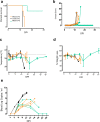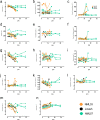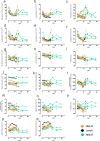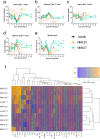Differential pathogenesis of closely related 2018 Nigerian outbreak clade III Lassa virus isolates
- PMID: 34634087
- PMCID: PMC8530337
- DOI: 10.1371/journal.ppat.1009966
Differential pathogenesis of closely related 2018 Nigerian outbreak clade III Lassa virus isolates
Abstract
Nigeria continues to experience ever increasing annual outbreaks of Lassa fever (LF). The World Health Organization has recently declared Lassa virus (LASV) as a priority pathogen for accelerated research leading to a renewed international effort to develop relevant animal models of disease and effective countermeasures to reduce LF morbidity and mortality in endemic West African countries. A limiting factor in evaluating medical countermeasures against LF is a lack of well characterized animal models outside of those based on infection with LASV strain Josiah originating form Sierra Leone, circa 1976. Here we genetically characterize five recent LASV isolates collected from the 2018 outbreak in Nigeria. Three isolates were further evaluated in vivo and despite being closely related and from the same spatial / geographic region of Nigeria, only one of the three isolates proved lethal in strain 13 guinea pigs and non-human primates (NHP). Additionally, this isolate exhibited atypical pathogenesis characteristics in the NHP model, most notably respiratory failure, not commonly described in hemorrhagic cases of LF. These results suggest that there is considerable phenotypic heterogeneity in LASV infections in Nigeria, which leads to a multitude of pathogenesis characteristics that could account for differences between subclinical and lethal LF infections. Most importantly, the development of disease models using currently circulating LASV strains in West Africa are critical for the evaluation of potential vaccines and medical countermeasures.
Conflict of interest statement
The authors have declared that no competing interests exist.
Figures











Similar articles
-
A recombinant vesicular stomatitis virus-based Lassa fever vaccine protects guinea pigs and macaques against challenge with geographically and genetically distinct Lassa viruses.PLoS Negl Trop Dis. 2015 Apr 17;9(4):e0003736. doi: 10.1371/journal.pntd.0003736. eCollection 2015 Apr. PLoS Negl Trop Dis. 2015. PMID: 25884628 Free PMC article.
-
Lethal Infection of Lassa Virus Isolated from a Human Clinical Sample in Outbred Guinea Pigs without Adaptation.mSphere. 2019 Sep 25;4(5):e00428-19. doi: 10.1128/mSphere.00428-19. mSphere. 2019. PMID: 31554720 Free PMC article.
-
Severe Human Lassa Fever Is Characterized by Nonspecific T-Cell Activation and Lymphocyte Homing to Inflamed Tissues.J Virol. 2020 Oct 14;94(21):e01367-20. doi: 10.1128/JVI.01367-20. Print 2020 Oct 14. J Virol. 2020. PMID: 32817220 Free PMC article.
-
Current research for a vaccine against Lassa hemorrhagic fever virus.Drug Des Devel Ther. 2018 Aug 14;12:2519-2527. doi: 10.2147/DDDT.S147276. eCollection 2018. Drug Des Devel Ther. 2018. PMID: 30147299 Free PMC article. Review.
-
Lassa fever - the road ahead.Nat Rev Microbiol. 2023 Feb;21(2):87-96. doi: 10.1038/s41579-022-00789-8. Epub 2022 Sep 12. Nat Rev Microbiol. 2023. PMID: 36097163 Free PMC article. Review.
Cited by
-
Pathogenic and Apathogenic Strains of Lymphocytic Choriomeningitis Virus Have Distinct Entry and Innate Immune Activation Pathways.Viruses. 2024 Apr 19;16(4):635. doi: 10.3390/v16040635. Viruses. 2024. PMID: 38675975 Free PMC article.
-
Lassa Fever Natural History and Clinical Management.Curr Top Microbiol Immunol. 2023;440:165-192. doi: 10.1007/82_2023_263. Curr Top Microbiol Immunol. 2023. PMID: 37106159
-
A human monoclonal antibody combination rescues nonhuman primates from advanced disease caused by the major lineages of Lassa virus.Proc Natl Acad Sci U S A. 2023 Aug 22;120(34):e2304876120. doi: 10.1073/pnas.2304876120. Epub 2023 Aug 17. Proc Natl Acad Sci U S A. 2023. PMID: 37590417 Free PMC article.
-
Fatal Lassa fever in cynomolgus monkeys is associated with systemic viral dissemination and inflammation.PLoS Pathog. 2024 Dec 9;20(12):e1012768. doi: 10.1371/journal.ppat.1012768. eCollection 2024 Dec. PLoS Pathog. 2024. PMID: 39652618 Free PMC article.
-
Pathogenesis of recent Lassa virus isolates from lineages II and VII in cynomolgus monkeys.Virulence. 2022 Dec;13(1):654-669. doi: 10.1080/21505594.2022.2060170. Virulence. 2022. PMID: 35437094 Free PMC article.
References
-
- Ogbu O, Ajuluchukwu E, Uneke CJ. Lassa fever in West African sub-region: An overview. Journal of Vector Borne Diseases. 2007. pp. 1–11. - PubMed
MeSH terms
LinkOut - more resources
Full Text Sources

